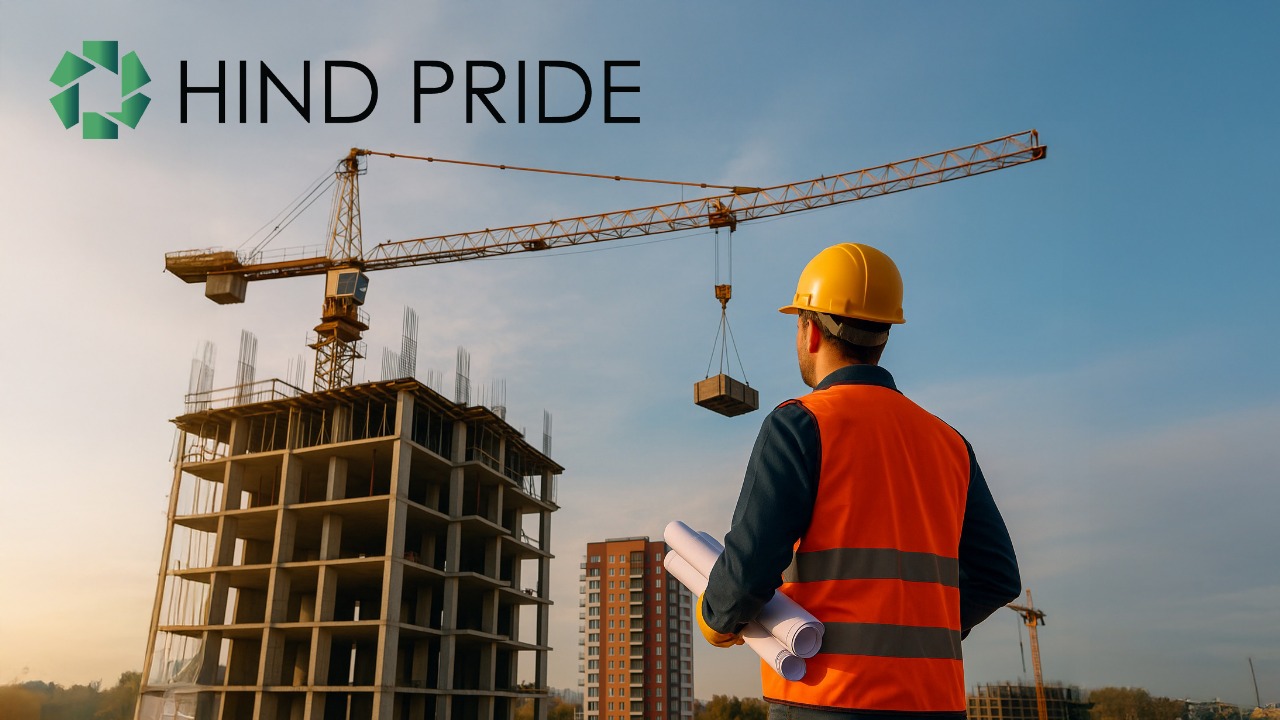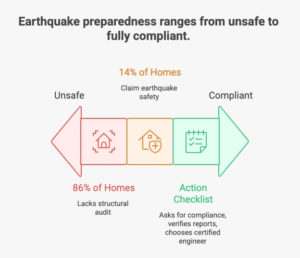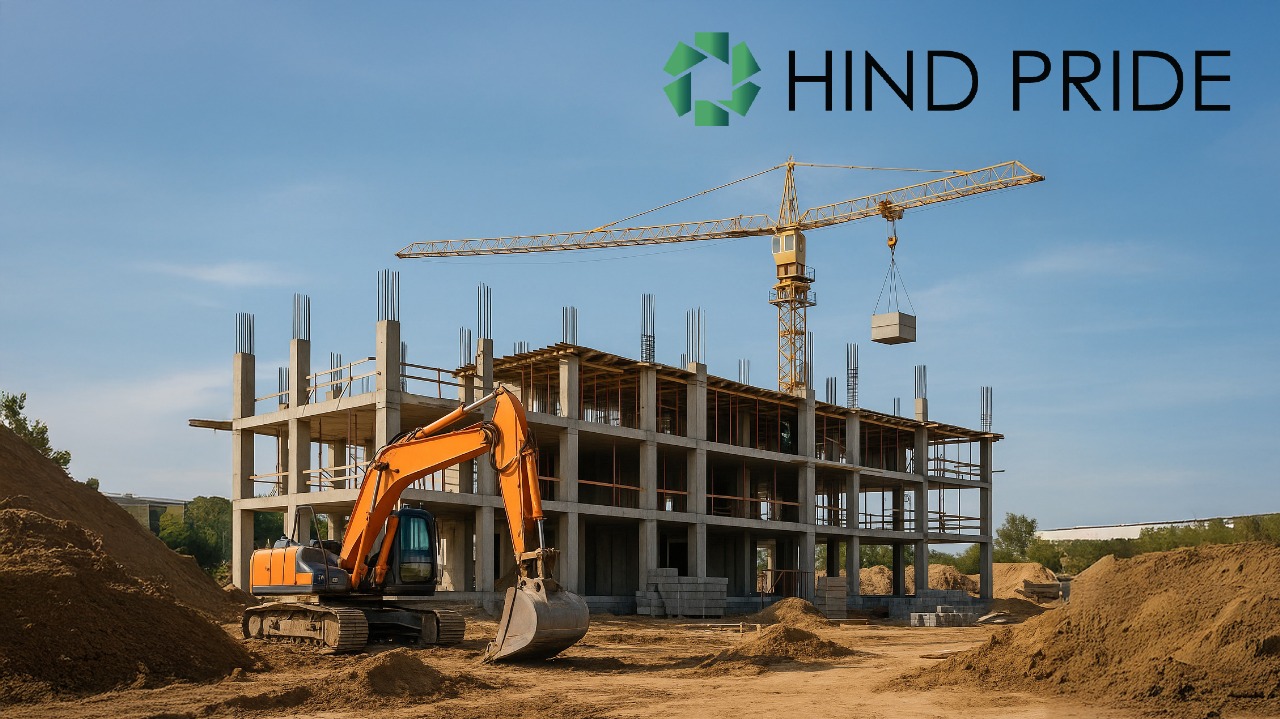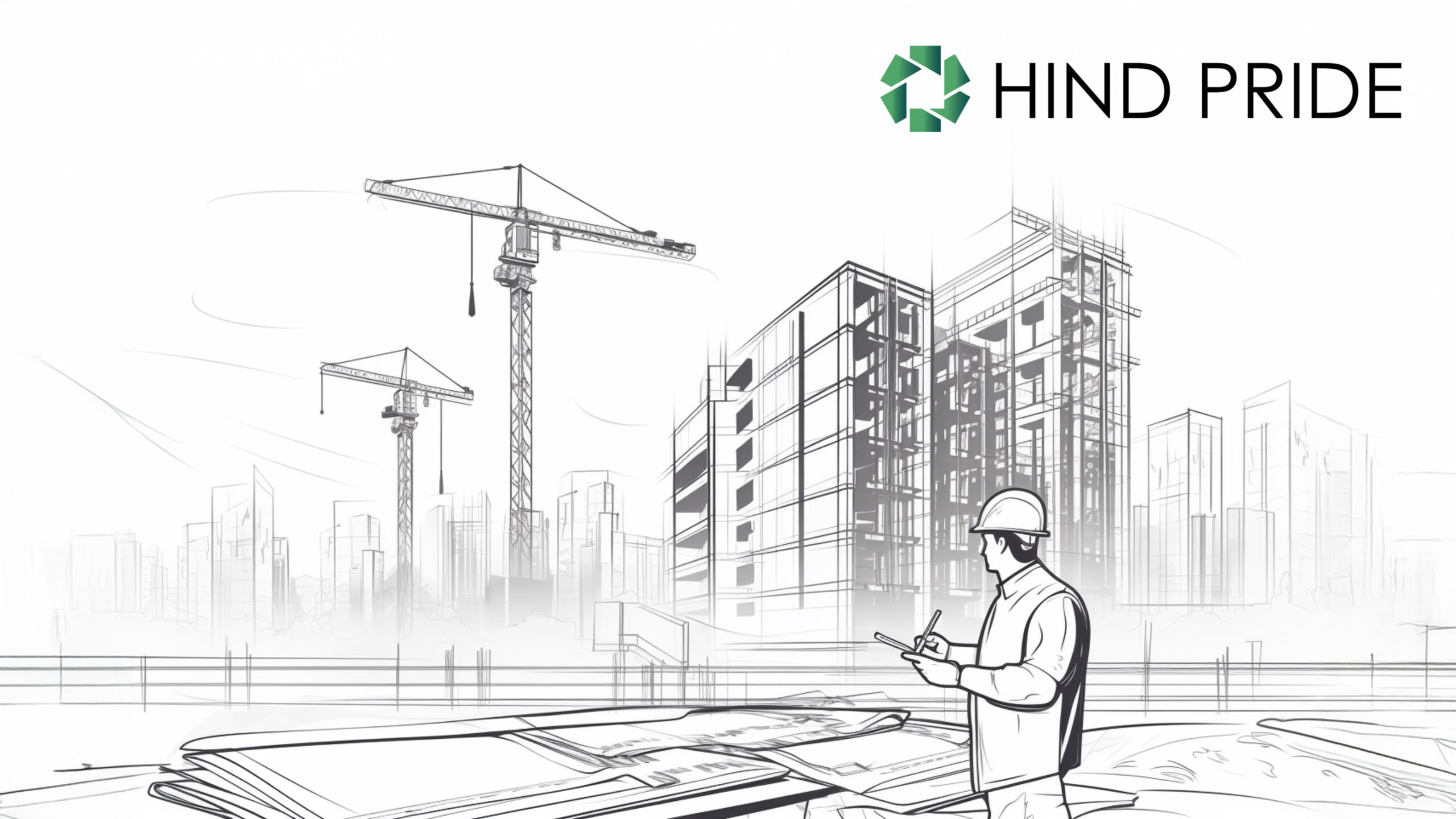

Table of Contents
ToggleDelhi Trembles. Your Home Shouldn’t.
Every few months, Delhi NCR jolts awake i was looking for Earthquake-Safe Builder NCR — a 4A.1-magnitude here, a 5.3-magnitude there — tremors that ripple through office towers, apartments, and farmhouses. People glance at their chandeliers, share quick social-media videos, and then carry on as if nothing happened. But geologists don’t shrug it off.
Delhi NCR lies right over the Himalayan Frontal Fault and the Delhi–Moradabad Fault, both known for significant seismic activity. According to the Bureau of Indian Standards, the entire region is placed in Seismic Zone IV, meaning severe damage potential.
Now here’s the shocker:
More than 60 % of NCR buildings are not fully compliant with modern seismic codes.
So, when you plan to build your dream villa in Gurugram, a farmhouse in Chhatarpur, or a modern home in Noida — your first question shouldn’t be about marble finishes or façade design. It should be:
“Is my builder an earthquake-safe NCR certified builder for Zone IV?”
Because design can be changed. Finishes can be upgraded. But structure? Once built wrong, it can’t be undone without tearing everything apart.
What Zone IV Really Means
India’s seismic map divides the country into Zones II to V. Zone IV is classified as “Severe Damage Risk Zone”, just one step below the catastrophic Zone V that includes the Himalayas and North-East states.
Delhi NCR’s inclusion is due to:
Even a 6.0 magnitude quake could cause partial collapse in unreinforced buildings.
Real Quakes, Not Hypotheticals
These are wake-up calls, not warnings to ignore.
A safe home doesn’t defy earthquakes. It dances with them. Engineers call it ductile behavior — the ability of a structure to sway, absorb, and redistribute forces without collapse.
1. The Codes That Save Lives
A true earthquake-safe builder NCR designs every column, beam, and joint to comply with these. They work with licensed structural engineers and verify calculations with third-party audits.
2. The Core Structural Principles
Each of these isn’t optional — they’re lifelines.
Before finalizing your builder, run this 10-point checklist. It’s your personal insurance policy.
Criterion | Ask Your Builder | Proof You Should Get | |
1 | IS 1893:2016 design compliance | “Can I see seismic load calculations?” | Signed structural design with Z = 0.24 factor for Zone IV |
2 | Ductile detailing as per IS 13920 | “Do you have reinforcement drawings?” | Beam-column joint details |
3 | Soil report | “Was soil testing done?” | Geotechnical report (SPT results) |
4 | Foundation design check | “Which foundation system are you using?” | Pile/raft design data |
5 | Material traceability | “Do you test concrete & steel batches?” | Lab test certificates |
6 | Structural engineer license | “Who designed this?” | COA/PEC registration copy |
7 | Third-party audit | “Was the design verified independently?” | Audit certificate |
8 | Seismic quality control | “Do you monitor vibration cracks?” | Site QC report |
9 | Warranty & maintenance | “What post-handover support?” | Structural warranty letter |
10 | Retrofitting readiness | “Can future changes maintain seismic safety?” | Structural flexibility statement |
You don’t need to be an engineer — you just need to demand documentation.
The best builder is not defined by how tall they build, but how intelligently they build. Here’s what sets them apart:
1. They Design with Empathy and Precision
Before they pour a single cube of concrete, they simulate quakes digitally using Finite Element Analysis (FEA) to see how the structure bends, vibrates, or cracks.
2. They Use BIM (Building Information Modeling)
BIM allows real-time collaboration between architects, engineers, and contractors. This ensures structural and architectural drawings never conflict — a major reason many unsafe buildings fail.
3. They Educate Clients
They’ll walk you through each safety layer. They’ll explain why rebar spacing matters, or why corner joints need confinement. Transparency is their policy.
4. They Provide Traceability
From rebar batch numbers to slump-test results, everything is documented. They might even share QR-coded material certificates.
5. They Test, Audit, and Certify
Top builders collaborate with institutions like NICEE-IIT Kanpur or CBRI Roorkee for structural validation. (NICEE)
That’s what gives them the right to call themselves an earthquake-safe builder NCR.
Proof: When Compliance Pays Off
Engineering Data
According to IIT Kanpur studies, ductile-detailed RCC frames experience 40 % less structural cracking during high-intensity tremors compared to non-ductile ones.
A 2024 report by Knight Frank found that homes advertised as “earthquake-resistant” in Delhi NCR fetch 8–12 % higher resale value, especially among NRIs seeking long-term stability.
Japan’s seismic codes increased building survival rates by 90 % after the 2011 Tohoku quake. India’s new NBC 2024 draft aims to emulate that rigor. (National Building Code 2024 Draft)
So, while safety may seem invisible, its value compounds over time — both financially and emotionally.

Even the most earthquake-safe homes Delhi NCR promise nothing unless the buyer holds the builder accountable.
Builders who are genuine will welcome such questions. Those who hesitate — avoid them.
Let’s imagine two identical villas in Gurgaon — Villa A and Villa B.
Villa A (Ordinary Builder)
Villa B (Earthquake-Safe Builder NCR)
A year later, tremors hit the city. Villa A shows cracked walls and misaligned doors. Villa B remains unaffected. Repair cost for Villa A: ₹ 6 lakh. Villa B: ₹ 0.
Safety is not expensive. Negligence is.
Beware of marketing greenwash. Builders may use buzzwords like “quake-proof,” which no structure truly is. Here’s how to spot pretenders:
Marketing Claim | Reality Check |
“Our design follows global standards” | Ask for BIS IS 1893 compliance certificate. |
“We use earthquake-proof materials” | No material alone ensures safety — design matters. |
“Our engineers are experts” | Verify credentials with the Council of Architecture or IEI. |
“We’re RERA registered” | RERA doesn’t automatically ensure seismic compliance. |
Always cross-verify. The Bureau of Indian Standards (BIS) and NDMA sites have updated lists of licensed auditors.
You might assume earthquake-resistant construction means astronomical budgets. Reality: it’s mostly better detailing and testing.
Component | % Increase | Why It’s Worth It |
Ductile detailing (extra steel, stirrups) | +3 % | Prevents brittle failure |
Soil testing & design audit | +1 % | Avoids foundation cracks |
Shear walls & bracing | +2 % | Adds stability |
Quality control & lab testing | +1 % | Guarantees strength |
Total Additional Cost | 5 – 7 % | Lifelong structural security |
That’s less than what most people spend upgrading kitchen fittings.
If you already own an older home, you can still improve safety. Structural retrofitting methods include:
However, retrofitting costs 1.5–2× more than designing safely from scratch. (CBRI Research Paper)
An earthquake-safe builder NCR often overlaps with green construction principles.
Thus, seismic safety aligns with environmental ethics — strong, sustainable, and sensible.
Parameter | Non-Compliant Homes | Compliant Homes | Source |
Delhi NCR housing stock (2025) | ~ 86 % | 14 % | |
Structures audited under NDMA scheme | < 10 % | – | NDMA |
Typical resale premium for compliant homes | – | 8–12 % | Knight Frank |
These figures underline why you must prioritize compliance when choosing your builder.
Financial ROI is measurable; emotional ROI isn’t — but it’s far greater. The peace of mind knowing your home can survive tremors is priceless. Families that live in earthquake-safe homes Delhi NCR sleep better, invest smarter, and even command higher tenant trust.
You can repaint walls, re-tile bathrooms, or change décor — but you can’t repaint structure after it collapses.
Builders like Hindpride Infra have redefined rural and urban construction through sustainable RCC panel systems and modular precision. Their engineering team focuses on seismic detailing even in farmhouse projects — because rural doesn’t mean relaxed safety.
If every developer in NCR adopted this philosophy — combining green materials with seismic audits — Delhi could truly become earthquake-ready.
1. What does Zone IV mean for homeowners in Delhi NCR?
Zone IV is classified by the Bureau of Indian Standards (BIS) as a high-risk seismic zone with the potential for severe earthquakes. Delhi NCR falls entirely in this zone due to nearby fault lines like Sohna, Mathura, and Delhi–Moradabad. This means homeowners must choose an earthquake-safe builder NCR who follows BIS codes (IS 1893 and IS 13920) to ensure structural safety.
2. What makes a home truly earthquake-safe?
An earthquake safe home Delhi NCR is built with ductile detailing, proper foundation design, shear walls, and flexible joints that absorb shock during tremors. The key lies not in materials alone but in correct engineering—especially compliance with IS 1893:2016 and IS 4326:2013. Always ask your builder for these design certifications.
3. How can I verify if my builder is earthquake-safe certified?
Ask your builder for:
Structural drawings with seismic load calculations (Zone IV factor = 0.24).
COA or IEI registration of the structural engineer.
Third-party audit certificate from a BIS-approved agency.
A legitimate earthquake-safe builder NCR will share these transparently before contract signing.
4. What is the cost difference between a regular and earthquake-safe home?
The cost difference is typically 5–8 %. That covers ductile detailing, soil testing, shear wall design, and material quality control. In return, your home gains lifetime durability and up to 12 % higher resale value, according to Knight Frank’s 2024 report.
5. Can older homes in Delhi NCR be made earthquake-safe?
Yes. Older structures can be retrofitted using techniques like column jacketing, steel bracing, or ferrocement overlays. However, retrofitting costs 1.5–2× more than building new earthquake safe homes Delhi NCR. Consult CBRI Roorkee or an IIT-certified engineer for retrofit assessment.
6. Which building codes must my builder follow for Zone IV compliance?
Essential codes include:
IS 1893:2016 – Seismic Design Criteria
IS 4326:2013 – Earthquake-Resistant Construction Practices
IS 13920:2016 – Ductile Detailing
National Building Code (NBC 2024) Draft
Choosing a compliant earthquake-safe builder NCR ensures all four standards are met.
7. Are RCC panel and modular homes safer during earthquakes?
Yes, if designed correctly. Precast RCC panel systems have uniform quality, lighter weight, and excellent ductility—reducing collapse risk. Builders like Hindpride use modular panels engineered for seismic flexibility, making them ideal for Zone IV and V regions.
8. Does BIS certification alone guarantee earthquake resistance?
Not entirely. BIS certification confirms design standards, but real safety depends on execution quality, material testing, and on-site supervision. A genuine earthquake-safe builder NCR pairs BIS-compliant design with rigorous third-party audits and site inspections.
9. What are red flags that a builder is not earthquake-safe?
Watch for these signs:
No soil test reports or load calculations.
Vague claims like “quake-proof materials.”
Unlicensed structural engineers.
Refusal to show audit certificates.
If you encounter these, the builder likely isn’t a verified earthquake-safe builder NCR.
10. Why is choosing an earthquake-safe builder so crucial in Delhi NCR?
Because the region’s seismic activity isn’t a matter of if but when. Choosing an earthquake-safe builder NCR ensures your home can absorb tremors, protect lives, and preserve long-term investment value. In a Zone IV city, structural safety is not a luxury—it’s survival.
The earth beneath Delhi NCR is restless — and always will be. What changes is our preparedness.
When you invest in a home, don’t just chase square footage. Chase structural truth. Partner with an earthquake-safe builder NCR who respects codes, tests materials, and values human life above glossy marketing.
Because someday, when the ground moves, you won’t have time to question your choices. You’ll simply be thankful that your home — your legacy — was built by someone who understood that real strength is silent.
“Live in Strength, Not in Fear.”
Discover how certified engineers and verified materials make your dream home earthquake-safe in Delhi NCR.
Free Zone IV Safety Audit
BIS & IIT-Certified Design Check
Lifetime Structural Warranty
Book Your Earthquake-Safety Consultation → Hindpride
Contact Number – +91 909-909-5581


